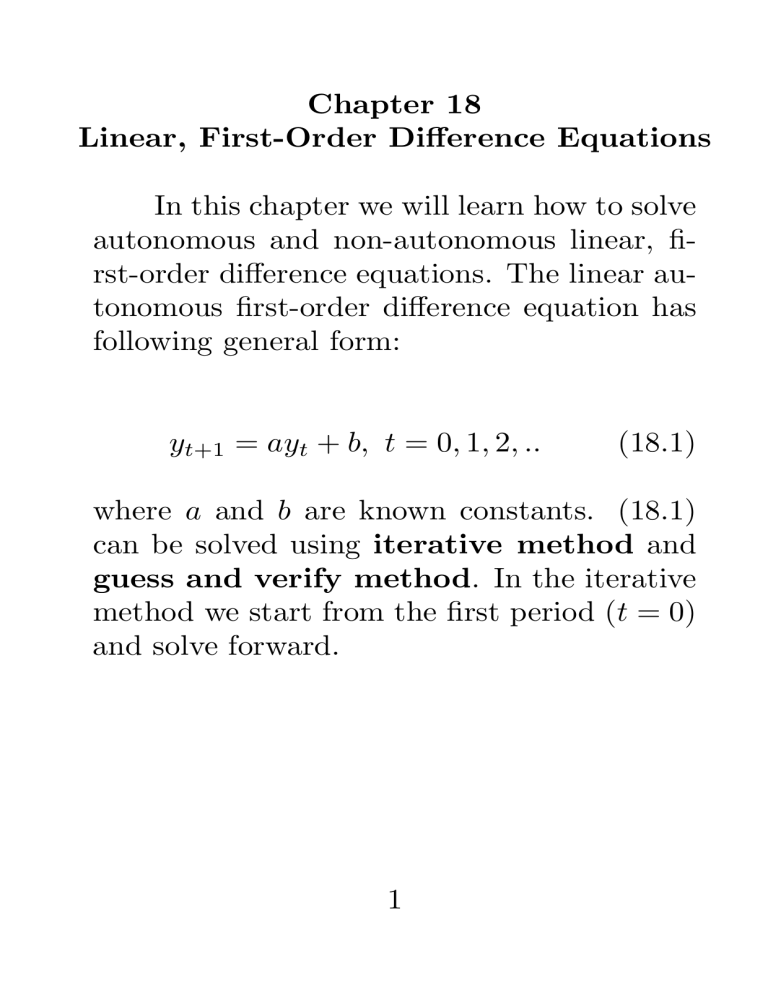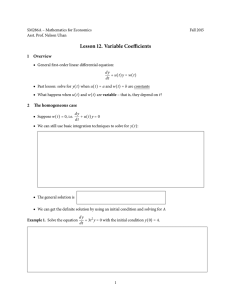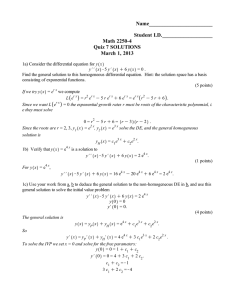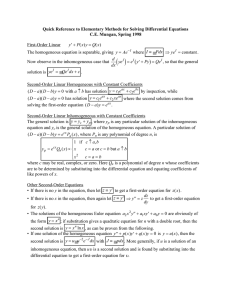
Chapter 18 Linear, First-Order Difference Equations In this chapter we will learn how to solve autonomous and non-autonomous linear, first-order difference equations. The linear autonomous first-order difference equation has following general form: yt+1 = ayt + b, t = 0, 1, 2, .. (18.1) where a and b are known constants. (18.1) can be solved using iterative method and guess and verify method. In the iterative method we start from the first period (t = 0) and solve forward. 1 The solution is µ t yt = a y0 + b t 1−a 1−a ¶ , if a 6= 1 (18.2) and yt = y0 + bt if a = 1 (18.3) (18.2) can also be written as µ yt = at y0 − b 1−a ¶ b + 1−a (18.4) b where as we will see below that 1−a is steady state value of y. Also steady state exists only in the case a 6= 1. If we know the initial condition (y0 ) we can use iterative method. In the case, we don’t know the initial condition we can still solve the difference equation using guess and 2 verify method. The general approach is very much identical to the one we used in solving first order linear autonomous differential equation. We divide the difference equation in two parts: steady state part and homogeneous part. The steady state solution y is given by y = ay + b which implies b y= 1−a (18.5) Notice that steady-state solution exists only when a 6= 1. The homogeneous part is given by yt+1 = ayt . (18.6) Now assume that the solution of homogeneous part has following form: 3 yh = Cdt (18.7) where C and d are two undetermined coefficients. Basically we have to find C and d which satisfy the differential equation (18.1). To do this, put (18.7) in (18.6), we get Cdt+1 = aCdt which implies d = a. (18.8) Thus the general solution for the homogeneous part is given by yh = Cat . (18.9) The complete solution for the differential equation (18.1) is given by y = yh + y which implies 4 b yt = Ca + if a 6= 1. 1−a t (18.10) Important Remark: The form of (18.10) is slightly different from what is given in the text book (Theorem 18.2). In the text book, the solution is of the form µ t yt = C1 a + b t 1−a 1−a ¶ (18.11) where C1 is some constant. (18.11) can be rewritten as µ yt = C1 1 − b 1−a ¶ b a + . 1−a t (18.12) Thus µ C = C1 1 − b 1−a 5 ¶ . (18.13) If we know, the initial value y0 then we can pin down C which turns out to be equal to b C = y0 − . 1−a (18.14) From (18.10) it is immediately clear that the solution will converge to steady state if and only if |a| < 1. In the case, a = 1 steady-state does not exist and one has to modify the guess. The homogeneous solution is still given by yh = Cat . But with a = 1, yh = C. (18.15) In order to find solution for non-homogeneous part assume that ynh = kt. Putting (18.16) in (18.1), we get k(t + 1) = kt + b 6 (18.16) which implies k = b. Thus, the solution for non-homogeneous part is ynh = bt. (18.17) The complete solution in the case a = 1 is given by, yt = yh + ynh which implies yt = C + bt. 7 (18.18) Non-autonomous Equation The general form of linear, non-autonomous, first-order difference equation is yt+1 = at yt + bt , t = 0, 1, 2, .. (18.19) By using iterative method one can show that the solution is given by yt = t−1 Y i=0 ai y0 + t−1 X k=0 8 bk t−1 Y i=k ai . ak (18.20)





